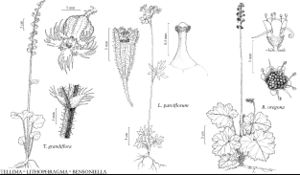Difference between revisions of "Tellima"
in J. Franklin et al., Narr. Journey Polar Sea, 765. 1823 ,.
FNA>Volume Importer |
imported>Volume Importer |
||
| (6 intermediate revisions by 2 users not shown) | |||
| Line 1: | Line 1: | ||
{{Treatment/ID | {{Treatment/ID | ||
|accepted_name=Tellima | |accepted_name=Tellima | ||
| − | |accepted_authority=R. Brown | + | |accepted_authority=R. Brown |
|publications={{Treatment/Publication | |publications={{Treatment/Publication | ||
|title=in J. Franklin et al., Narr. Journey Polar Sea, | |title=in J. Franklin et al., Narr. Journey Polar Sea, | ||
| Line 22: | Line 22: | ||
|distribution=w North America. | |distribution=w North America. | ||
|discussion=<p>Species 1: w North America.</p><!-- | |discussion=<p>Species 1: w North America.</p><!-- | ||
| − | --><p>Based on ITS-1 and ITS-2 analysis by D. E. Soltis and R. K. Kuzoff (1995), Tellima is closest to Lithophragma.</p><!-- | + | --><p>Based on ITS-1 and ITS-2 analysis by D. E. Soltis and R. K. Kuzoff (1995), <i>Tellima</i> is closest to <i>Lithophragma</i>.</p><!-- |
--><p>Species 1</p> | --><p>Species 1</p> | ||
|tables= | |tables= | ||
| Line 33: | Line 33: | ||
name=Tellima | name=Tellima | ||
|author=Elizabeth Fortson Wells;Patrick E. Elvander† | |author=Elizabeth Fortson Wells;Patrick E. Elvander† | ||
| − | |authority=R. Brown | + | |authority=R. Brown |
|rank=genus | |rank=genus | ||
|parent rank=family | |parent rank=family | ||
| Line 44: | Line 44: | ||
|publication year= | |publication year= | ||
|special status= | |special status= | ||
| − | |source xml=https:// | + | |source xml=https://bitbucket.org/aafc-mbb/fna-data-curation/src/2e0870ddd59836b60bcf96646a41e87ea5a5943a/coarse_grained_fna_xml/V8/V8_148.xml |
|genus=Tellima | |genus=Tellima | ||
}}<!-- | }}<!-- | ||
-->[[Category:Treatment]][[Category:Saxifragaceae]] | -->[[Category:Treatment]][[Category:Saxifragaceae]] | ||
Latest revision as of 22:41, 5 November 2020
Herbs, not rhizomatous, not stoloniferous; caudex erect, scaly. Flowering stems erect, leafy, 40–90 cm, densely stipitate-glandular. Leaves in basal rosette and cauline; cauline leaves 2–3, alternate, relatively large, reduced distally; stipules present; petiole stipitate-glandular; blade orbiculate or ovate, shallowly 5–9-lobed, base cordate, ultimate margins serrate to crenate, apex acute or rounded, surfaces sparsely stipitate-glandular on veins abaxially, sparsely to moderately densely long stipitate-glandular or glandular-hispid adaxially; venation palmate. Inflorescences racemes, terminal from axillary buds in rosette, 14–30-flowered, bracteate. Flowers: hypanthium adnate to ovary in proximal 1/2, free 2–3 mm, green; sepals 5, greenish; petals 5, greenish white or cream to pinkish red (sometimes drying dark red); nectary tissue not seen or inconspicuous; stamens 10; filaments filiform; ovary 1/4 inferior, 1-locular; placentation parietal; styles 2; stigmas 2, (enlarged). Capsules 2-beaked. Seeds dark brown, ellipsoid, warty. x = 7.
Distribution
w North America.
Discussion
Species 1: w North America.
Based on ITS-1 and ITS-2 analysis by D. E. Soltis and R. K. Kuzoff (1995), Tellima is closest to Lithophragma.
Species 1
Selected References
None.
